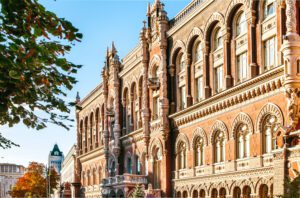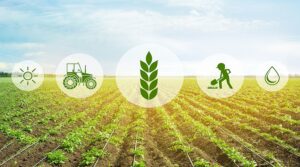
The International Monetary Fund’s four-year extended EFF financing program for Ukraine also envisions the country receiving $80 billion from multilateral and bilateral donors during this period, including $20 billion in grants and $60 billion in concessional loans, as well as another $20 billion in debt flow relief, said Gavin Gray, head of the Fund mission.
At a press conference on Friday, after announcing the decision to approve the $15.6 billion EFF program, he recalled two announcements made last week: from a group of official Ukrainian creditors about their willingness to defer the country’s debt payments for the program period and about Ukraine’s intention to agree the same with the holders of Eurobonds and other external commercial debts.

Ukrainian agricultural producers in 2022 attracted 43.65 thousand loans totaling 95.47 billion UAH under the program “Affordable credits 5-7-9”, according to the website of the Ministry of Agrarian Policy and Food of Ukraine on Monday.
It says that from the middle of March to May 31, 2022 a special program of concessional lending for the sowing season, under which farmers could borrow up to 60 million hryvnia at 0% per annum, and the state guaranteed 80% of funding. During the period of its operation the agrarian entrepreneurs received 24,72 billion UAH of credits. From June 1, 2022, the usual program “5-7-9” was applied for loans to agricultural sector.
The leaders in terms of credit amounts during this period were the Kiev region – 15,5 billion UAH, Vinnitsa region – 10,2 billion UAH, Kirovograd region – 8,6 billion UAH, Dnepropetrovsk region – 6,8 billion UAH and Odessa region – 6 billion UAH.
PrivatBank, Raiffeisen Bank, Ukrgasbank, Oschadbank, Ukreximbank, Credit Agricole and PUMB granted the most loans to agrarians.
The agency also recalled that the Ukrainian government has decided to provide financial support to micro, small and medium enterprises to restore partially or completely destroyed as a result of military operations of production facilities. Agribusinesses can also count on such support.
Besides, banks credit business for energy supply: purchase and installation of equipment ensuring uninterrupted work of business energy systems. Lending for such investments is made at an interest rate of 0% per annum.

Banks issued 4.42 thousand concessional loans under the state program “Affordable loans 5-7-9%” for UAH 10.27 billion in the last month of 2022, which is 21% or UAH 2.2 billion more than in November 2022, the Ministry of Finance said on its website on Monday.
According to its data, 1.66 thousand such loans worth 8.1 billion UAH were issued in November.
The Ministry of Finance specified that since the start of the program “5-7-9” business entities have received 52.85 thousand loans totaling 165.77 billion UAH from authorized banks, of which almost 34 thousand – from banks in the public sector for a total of 66.26 billion UAH.
It is noted that during the martial law in Ukraine as part of the state program 18.03 thousand loan agreements totaling 76.15 billion UAH (including 13.52 thousand by public sector banks for 39.62 billion UAH) were concluded.
According to the published data, the most credits were granted for war purposes – 38.35 billion UAH, 0.82 billion UAH of credit means were given to entrepreneurs for investment purposes, 6.34 billion UAH were allocated as anti-crisis credits, 4.38 billion UAH were given as refinancing of already received loans and 25.74 billion UAH were loans for agricultural producers.
As reported, the state program “Affordable credits 5-7-9%” with compensation of interest rates by the state was initiated in February 2020 to support projects of Ukrainian micro and small enterprises. Provision of three possible rates – 5%, 7% or 9% – on loans depends on the size of the business and the period of its operation. At the end of October last year the Cabinet of Ministers made changes to the conditions for granting loans under the program “Affordable credits 5-7-9%” and allowed to involve private entrepreneurs with annual income up to UAH 50 mln), also it became possible to fully compensate the rate.
Now 45 banks work with the program “Affordable credits 5-7-9%”.
As the National Bank reported in its Financial Stability Report in late 2022, the prevalence of programs with up to zero rate compensation, rising market interest rates and rapid portfolio growth have significantly increased the government’s financing costs for the program: more than 9 billion UAH must be paid this year instead of the planned 3 billion UAH, resulting in a government debt of 2.6 billion UAH as of early November, which is equivalent to two months of interest compensation and has kept banks from further using the program.
“In conditions of war, government support is a guarantee of business access to credit. So the weighty role of the program will remain in 2023. Since expanding the program will require additional resources, its design should be optimized. Most businesses have already adapted to the war and have resumed production, so an increase in rates should be considered. A separate design is needed for the program for agricultural producers, given the difficulties with the sale of crops due to the destruction of logistics,” pointed out the National Bank.
According to statistics from the NBU, if at the end of 2020, loans provided by the program “5-7-9”, took 5% of the net corporate portfolio of hryvnia, then at the end of 2021 – 18%, and as of December 2022 – 26%.
In turn, head of the Ministry of Finance Serhiy Marchenko reported that the state budget-2023 provides for 14 billion UAH for the program.

In 2022, Ukrainian agricultural producers attracted 26,620 loans totaling UAH 47.74 million under the Affordable Loans 5–7–9 program, the website of the Ministry of Agrarian Policy and Food reported on Thursday.
The report clarifies that from mid-March to May 31, 2022, a special program was in place for preferential lending for sowing crops, under which farmers could raise up to UAH 60 million at 0% per annum, and 80% was guaranteed by the state. In total, during the period of its work, agricultural entrepreneurs received UAH 38.51 billion in loans. Since June 1, applications for lending to the agricultural sector have been accepted within the framework of the usual 5-7-9 program.
With its help, small and medium-sized agricultural entrepreneurs receive loans for the purchase of fixed assets and reimbursement of any expenses associated with the implementation of agricultural activities. The program is also aimed at creating jobs in enterprises.
In total, for the period June 1-July 21, Ukrainian banks allocated UAH 9.19 billion to 8.53 thousand agrarians and farmers, including UAH 443.8 thousand under the portfolio guarantee program.
The leaders in terms of lending for this period were Kyiv – UAH 1.540 billion, Khmelnytsky – UAH 1 billion, Kirovohrad – UAH 0.66 billion, Vinnitsa and Poltava – UAH 0.61 billion each.
The largest lending volumes for the specified period came from: Raiffeisen Bank – UAH 3.29 billion, Oschadbank – UAH 1.71 billion, PrivatBank – UAH 1.18 billion, Ukrgasbank – UAH 0.91 billion, Ukreximbank – UAH 0.61 billion.
“The government and the Ministry of Agrarian Policy are well aware of how important it is for farmers to receive preferential loans during the war. Therefore, we are working on launching new credit lines for farmers, and we also expect that in the near future the conditions for paying the body of the loan on preferential lending will be extended from 6 to 12 months,” the ministry quotes its first deputy minister, Taras Vysotsky.

Ukrainian banking institutions from the middle of March to May 25, under the government program to support the sowing season 2022, provided loans to farmers for a total of UAH 31.5 billion, including loans and portfolio guarantees for UAH 3.4 billion.
According to the data published on the website of the Ministry of Agrarian Policy and Food of Ukraine, 80% (UAH 20.3 billion) of loans provided were portfolio guarantees, while a total of 13,060 agricultural producers received access to financing (last week it was 1,740).
Most loans for the sowing season were attracted by farmers of Kirovohrad (UAH 4.91 billion), Kyiv (UAH 3.37 billion), Vinnytsia (UAH 2.92 billion), Dnipropetrovsk (UAH 2.52 billion) and Odesa regions (UAH 2.48 billion).
According to the Ministry of Agrarian Policy, loans up to UAH 60 million as part of the support for the 2022 sowing season are issued at 0% per annum (under the government financial support program Affordable Loans 5-7-9%). The term of such lending is up to six months, and after its completion, the interest rate for borrowers will be 5% per annum. Such financing can be used by farmers who fall under the definition of an agricultural producer.

State-controlled PrivatBank (Kyiv) issued UAH 6 billion in loans to 2,300 agricultural producers for the sowing campaign, the bank’s press service reported on Saturday.
“Ukrainian agricultural enterprises and farmers have already received UAH 6 billion of preferential loans for sowing from PrivatBank. Funding for spring work has been provided to 2,300 farms under the state program of preferential lending to agricultural producers,” the report says.
As reported, PrivatBank began issuing agricultural loans under the state support program on March 24. The program provides loans in the amount of up to UAH 5 million without collateral and insurance, as well as interest rate compensation, due to which customers pay 0% per annum with a one-time commission payment of up to 1% of the loan amount.
In order to receive a loan in the amount of more than UAH 5 million, the agricultural producer must additionally pledge agricultural machinery, which will provide at least 20% of the loan amount.
According to the statistics of the National Bank of Ukraine, as of January 1, 2022, PrivatBank ranked first in terms of total assets (UAH 582.85 billion) among 71 banks operating in the country.